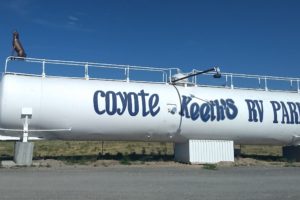About 8 miles from the command facility is the launch silo for one of the Minuteman missiles from the Cold War that’s controlled from Oscar-Zero. There’s nothing around here, just flat ground, except for November-33.



But below ground is a whole other story. These 2 pictures are from the layout we saw at control facility.


The “Ace in the Hole”



The Minuteman’s development as a solid-fueled missile eliminated many of these weaknesses. Solid fuel allowed the Minuteman to safely and constantly be on alert in an isolated launch facility like this one. And it could be launched almost instantaneously.
The smaller, safer, and less costly ICBMs allowed the U.S. arsenal to grow. Between 1962 and 1967, the U.S. developed and deployed 1000 operational Minuteman missiles.
Minuteman II offered a number of advantages over the early missiles. An improved guidance system gave the new missile greater accuracy. Improved boosters increased the missile’s range from 6300 miles to 7000 miles. A new warhead could unleash a nuclear terror about 80 times more than the bomb dropped on Hiroshima, Japan, in 1945.

In response to START, the treaty signed in 1991, the 321st SMW was deactivated. All of the Minuteman III ICBMs were removed from their silos and the silos were imploded. But . . . the U.S. still has 450 fully operational Minuteman III missiles spread out over 3 Air Force Bases.



The wedge-shaped launcher closure door weighs 107.5 tons and is 4.5 feet thick. A few feet below this door was a nuclear-tipped Minuteman missile. The door needed to be heavy and thick enough so enemies couldn’t move or penetrate it to access the missile or its nuclear warheads. The door also needed to have enough mass and size to help the missile survive a nearby nuclear blast But it couldn’t be so heavy or large or immovable—at times the door needed to be readily opened.
To provide access for maintenance, a temporary “pipe pusher” was added by the launcher closure door. This pipe pusher used the cogged rail between the 2 smooth rails to hydraulically roll the door open or close it. The door’s four 18-inch wheels rolled along the smooth rails. These rails were a steady but slow way to open the massive door.


bottom picture: spectators outside a launch silo in Montana watching a test of the launcher closure door—7000 sandbags stopped the door after the gas actuators successfully fired and started the door moving along the rails (2000)
moving the missile to the silo
Moving the missiles and their nuclear warheads wasn’t easy, but it had to be done smoothly and efficiently. The Minuteman missile system meant that all components, no matter their size, could be transported back to Grand Forks Air Force Base for repair and new components brought out to replace aged or faulty components.
Also, as new upgrades were available, the missiles had to be moved around. To remove, replace, and transport the missiles, the Air Force designed special vehicles.

The second vehicle was the Transporter Erector (TE), a self-contained environmentally controlled system that transported, removed, and installed the Minuteman III ICBM downstages (the rocket portion).

The launcher closure door was opened, pulleys were attached to the missile, and it was hoisted into the trailer. Once the missile was in the trailer, the maintainers would then lower the trailer back to the horizontal position and drive the TE and missile back to Grand Forks AFB.
The PT and the TE were common sights on eastern North Dakota roads. The movement of these critical nuclear components with their warheads involved a special security convoy of numerous Air Force security forces, a U.S. Marshall, and a helicopter flying overhead.
personnel entrance



time for lunch





This full-service restaurant is for sale if you’re interested.


countryside
As we were driving through the countryside, we kept seeing bodies of water like this one.


We’re done with Jamestown now and ready to take off for northeast North Dakota. But our new campground wasn’t available for Saturday night when we had to leave where we were, so we found a delightful Harvest Host place for a boon-docking overnight.




